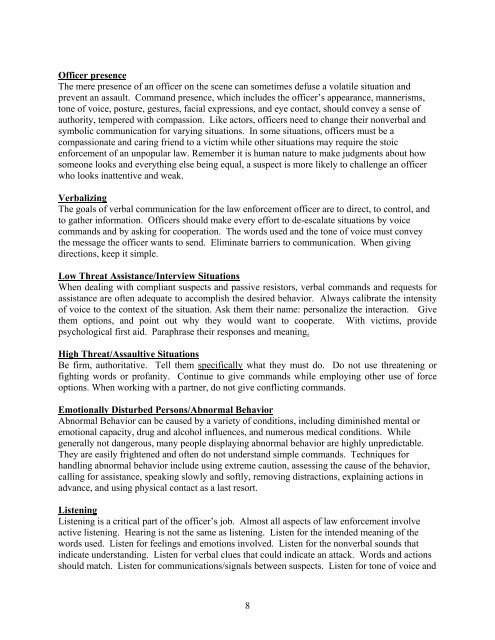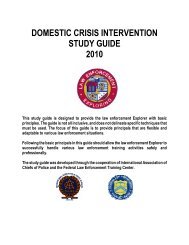ARREST AND SEARCH TECHNIQUES STUDY ... - Learning for Life
ARREST AND SEARCH TECHNIQUES STUDY ... - Learning for Life
ARREST AND SEARCH TECHNIQUES STUDY ... - Learning for Life
You also want an ePaper? Increase the reach of your titles
YUMPU automatically turns print PDFs into web optimized ePapers that Google loves.
Officer presenceThe mere presence of an officer on the scene can sometimes defuse a volatile situation andprevent an assault. Command presence, which includes the officer’s appearance, mannerisms,tone of voice, posture, gestures, facial expressions, and eye contact, should convey a sense ofauthority, tempered with compassion. Like actors, officers need to change their nonverbal andsymbolic communication <strong>for</strong> varying situations. In some situations, officers must be acompassionate and caring friend to a victim while other situations may require the stoicen<strong>for</strong>cement of an unpopular law. Remember it is human nature to make judgments about howsomeone looks and everything else being equal, a suspect is more likely to challenge an officerwho looks inattentive and weak.VerbalizingThe goals of verbal communication <strong>for</strong> the law en<strong>for</strong>cement officer are to direct, to control, andto gather in<strong>for</strong>mation. Officers should make every ef<strong>for</strong>t to de-escalate situations by voicecommands and by asking <strong>for</strong> cooperation. The words used and the tone of voice must conveythe message the officer wants to send. Eliminate barriers to communication. When givingdirections, keep it simple.Low Threat Assistance/Interview SituationsWhen dealing with compliant suspects and passive resistors, verbal commands and requests <strong>for</strong>assistance are often adequate to accomplish the desired behavior. Always calibrate the intensityof voice to the context of the situation. Ask them their name: personalize the interaction. Givethem options, and point out why they would want to cooperate. With victims, providepsychological first aid. Paraphrase their responses and meaning.High Threat/Assaultive SituationsBe firm, authoritative. Tell them specifically what they must do. Do not use threatening orfighting words or profanity. Continue to give commands while employing other use of <strong>for</strong>ceoptions. When working with a partner, do not give conflicting commands.Emotionally Disturbed Persons/Abnormal BehaviorAbnormal Behavior can be caused by a variety of conditions, including diminished mental oremotional capacity, drug and alcohol influences, and numerous medical conditions. Whilegenerally not dangerous, many people displaying abnormal behavior are highly unpredictable.They are easily frightened and often do not understand simple commands. Techniques <strong>for</strong>handling abnormal behavior include using extreme caution, assessing the cause of the behavior,calling <strong>for</strong> assistance, speaking slowly and softly, removing distractions, explaining actions inadvance, and using physical contact as a last resort.ListeningListening is a critical part of the officer’s job. Almost all aspects of law en<strong>for</strong>cement involveactive listening. Hearing is not the same as listening. Listen <strong>for</strong> the intended meaning of thewords used. Listen <strong>for</strong> feelings and emotions involved. Listen <strong>for</strong> the nonverbal sounds thatindicate understanding. Listen <strong>for</strong> verbal clues that could indicate an attack. Words and actionsshould match. Listen <strong>for</strong> communications/signals between suspects. Listen <strong>for</strong> tone of voice and8








